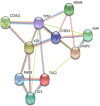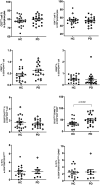Inflammation and regulatory T cell genes are differentially expressed in peripheral blood mononuclear cells of Parkinson's disease patients
- PMID: 33504893
- PMCID: PMC7841172
- DOI: 10.1038/s41598-021-81961-7
Inflammation and regulatory T cell genes are differentially expressed in peripheral blood mononuclear cells of Parkinson's disease patients
Abstract
Our aim was to identify the differentially expressed genes (DEGs) in peripheral blood mononuclear cells (PBMC) of Parkinson's disease (PD) patients and healthy controls by microarray technology and analysis of related molecular pathways by functional annotation. Thirty PD patients and 30 controls were enrolled. Agilent Human 8X60 K Oligo Microarray was used for gene level expression identification. Gene ontology and pathway enrichment analyses were used for functional annotation of DEGs. Protein-protein interaction analyses were performed with STRING. Expression levels of randomly selected DEGs were quantified by real time quantitative polymerase chain reaction (RT-PCR) for validation. Flow cytometry was done to determine frequency of regulatory T cells (Tregs) in PBMC. A total of 361 DEGs (143 upregulated and 218 downregulated) were identified after GeneSpring analysis. DEGs were involved in 28 biological processes, 12 cellular components and 26 molecular functions. Pathway analyses demonstrated that upregulated genes mainly enriched in p53 (CASP3, TSC2, ATR, MDM4, CCNG1) and PI3K/Akt (IL2RA, IL4R, TSC2, VEGFA, PKN2, PIK3CA, ITGA4, BCL2L11) signaling pathways. TP53 and PIK3CA were identified as most significant hub proteins. Expression profiles obtained by RT-PCR were consistent with microarray findings. PD patients showed increased proportions of CD49d+ Tregs, which correlated with disability scores. Survival pathway genes were upregulated putatively to compensate neuronal degeneration. Bioinformatics analysis showed an association between survival and inflammation genes. Increased CD49d+ Treg ratios might signify the effort of the immune system to suppress ongoing neuroinflammation.
Conflict of interest statement
The authors declare no competing interests.
Figures




Similar articles
-
Gene expression profiling predicts pathways and genes associated with Parkinson's disease.Neurol Sci. 2016 Jan;37(1):73-79. doi: 10.1007/s10072-015-2360-5. Epub 2015 Aug 13. Neurol Sci. 2016. PMID: 26269422
-
Evaluation of Long Non-coding RNA Expression Profiles in Peripheral Blood Mononuclear Cells of Patients with Parkinson's Disease.Mol Neurobiol. 2023 Nov;60(11):6201-6211. doi: 10.1007/s12035-023-03470-0. Epub 2023 Jul 12. Mol Neurobiol. 2023. PMID: 37436601
-
Intratumoral regulatory T cells with higher prevalence and more suppressive activity in hepatocellular carcinoma patients.J Gastroenterol Hepatol. 2013 Sep;28(9):1555-64. doi: 10.1111/jgh.12202. J Gastroenterol Hepatol. 2013. PMID: 23517245
-
Expression changes of genes associated with apoptosis and survival processes in Parkinson's disease.Neurosci Lett. 2016 Feb 26;615:72-7. doi: 10.1016/j.neulet.2016.01.029. Epub 2016 Jan 22. Neurosci Lett. 2016. PMID: 26806867
-
Identification of candidate biomarkers and pathways associated with SCLC by bioinformatics analysis.Mol Med Rep. 2018 Aug;18(2):1538-1550. doi: 10.3892/mmr.2018.9095. Epub 2018 May 29. Mol Med Rep. 2018. PMID: 29845250 Free PMC article.
Cited by
-
The Contribution of Microglia to Neuroinflammation in Parkinson's Disease.Int J Mol Sci. 2021 Apr 28;22(9):4676. doi: 10.3390/ijms22094676. Int J Mol Sci. 2021. PMID: 33925154 Free PMC article. Review.
-
Regulatory T Cell Therapeutics for Neuroinflammatory Disorders.Crit Rev Immunol. 2022;42(2):1-27. doi: 10.1615/CritRevImmunol.2022045080. Crit Rev Immunol. 2022. PMID: 37017285 Free PMC article. Review.
-
Mutant LRRK2 in lymphocytes regulates neurodegeneration via IL-6 in an inflammatory model of Parkinson's disease.NPJ Parkinsons Dis. 2022 Mar 15;8(1):24. doi: 10.1038/s41531-022-00289-9. NPJ Parkinsons Dis. 2022. PMID: 35292674 Free PMC article.
-
Peripheral inflammatory immune response differs among sporadic and familial Parkinson's disease.NPJ Parkinsons Dis. 2023 Jan 31;9(1):12. doi: 10.1038/s41531-023-00457-5. NPJ Parkinsons Dis. 2023. PMID: 36720879 Free PMC article.
-
Blood-Based Transcriptomic Biomarkers Are Predictive of Neurodegeneration Rather Than Alzheimer's Disease.Int J Mol Sci. 2023 Oct 9;24(19):15011. doi: 10.3390/ijms241915011. Int J Mol Sci. 2023. PMID: 37834458 Free PMC article.
References
Publication types
MeSH terms
Grants and funding
LinkOut - more resources
Full Text Sources
Other Literature Sources
Medical
Research Materials
Miscellaneous

